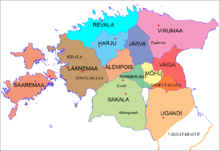| Vironia Virumaa | |||||||
|---|---|---|---|---|---|---|---|
| County of Estonia | |||||||
| 1227 | |||||||
 Ancient Estonia | |||||||
| Capital | Tarvanpää | ||||||
| Area | |||||||
| • Coordinates | 59°10′N 26°30′E / 59.17°N 26.5°E | ||||||
• 1220 | 7,387 km2 (2,852 sq mi) | ||||||
| |||||||
Virumaa (Latin: Vironia; Low German: Wierland; Old Norse: Virland) is a former independent county in Ancient Estonia. Now it is divided into Ida-Viru County or Eastern Vironia and Lääne-Viru County or Western Vironia. Vironians built many strongholds, like Tarwanpe (modern Rakvere) and Agelinde (now Punamägi Hill in Äntu village).
Vironian was divided into five clans (kilikunda), Maum (in Estonian "Mahu"), Laemund (Lemmu) also known as Pudiviru, Askele, Revele (Rebala), Alentagh (Alutaguse). Like other Estonian tribes, Vironians remained predominantly pagan before Northern Crusades in the 13th century.
